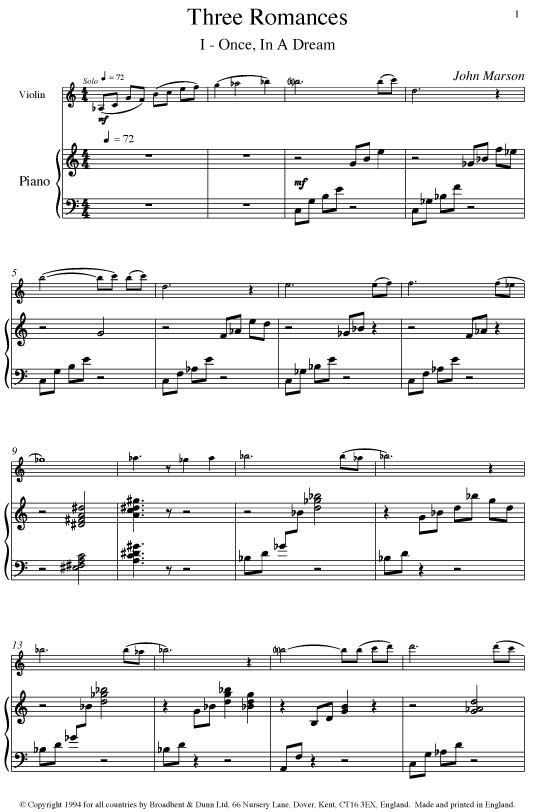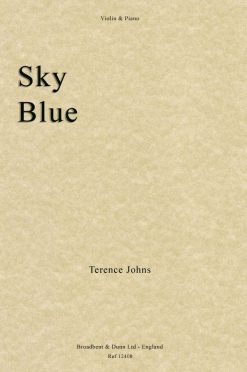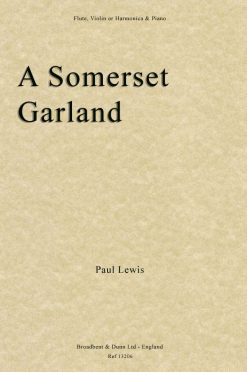£6.95
Piece Description
Additional information
| Media | |
|---|---|
| Composer | |
| Instrumentation | |
| Difficulty | |
| Series | |
| Movement Titles | Once In a Dream, A Place That I Knew and The Sweetest Memories |
Biography
Biography
Marson, John
John Marson was born in 1932 and died in 2007. He studied the harp with Marie Goossens at the Royal College of Music in London, and in 1958, while still a student, began his professional career with the Carl Rosa Opera Company. A week after leaving college he joined the London Symphony Orchestra for two years before embarking on two decades of freelance work, during which he played solos, chamber music and concerti, worked with all the London orchestras and spent much time in recording studios. He played in many outstanding feature films including the original 'Star Wars'. In 1982 he was appointed principal harp of the BBC Symphony Orchestra, and subsequently resumed his freelance career while increasingly engaging in composition, both for the harp and for other instruments and voice. He played for many West End and National Theatre productions including over three years as harpist in Lloyd Webber's 'Aspects of Love'.
The roll call of artists with whom John has worked include the Beatles, Richard Rodney Bennett, Leonard Bernstein, Pierre Boulez, Benjamin Britten, Charlie Chaplin, Bing Crosby, John Dankworth, Duke Ellington, Benny Goodman, Liberace, Martha Graham, Hans Werner Henze, Herbert von Karajan, Otto Klemperer, Zoltan Kodaly, Lorin Maazel, Neville Marriner, Pierre Monteux, Jessye Norman, Laurence Olivier, Luciano Pavarotti, Gennadi Rozhdestvenski, Frank Sinatra, George Solti, Leopold Stokowski, Igor Stravinsky, George Szell, William Walton, John Williams, Stevie Wonder and countless others.
In 1964 John was one of the two founders of the United Kingdom Harp Association, edited its magazines for many years and became President of the Association in January 2005. His book 'The Complete Guide to Harp Glissandi', is published by Lyra Music of New York, while his other major work 'The Book of the Harp - techniques, history and lore of a unique musical instrument', was published by Kevin Mayhew Ltd. in 2005.

Related products
Violin & Piano
Violin & Piano
Terence Johns – Sky Blue (Violin & Piano) – Digital Download
Violin & Piano
Arrangements of Somerset folk songs to give them a new lease of life and introduce them to audiences who might never otherwise hear them. Very popular with audiences, its individual movements are useful as fillers or encores. Martock Jig and Langport March are also playable on Piccolo. It is a very direct and enjoyable work and is also versatile, with versions for flute, violin or harmonica with piano accompaniment. The original harmonica version is very idiomatically written by the composer, who was long associated with the late great virtuoso Tommy Reilly. It is folk material very well suited to the instrument. For teaching studios, conservatories, libraries, amateurs and professionals. The last movement of this work Langport March was a Trinity College London Grade 5 Exam Piece for Flute between 2007 and 2022.
Violin & Piano
Alfonso Cavallaro – Serenade for Violin and Piano Opus Posth. 2 No 1 – Digital Download
Violin & Piano
Lenny Cavallaro – Sonata No. 1 in D Minor for Violin and Piano (or Harpsichord) Opus 4








